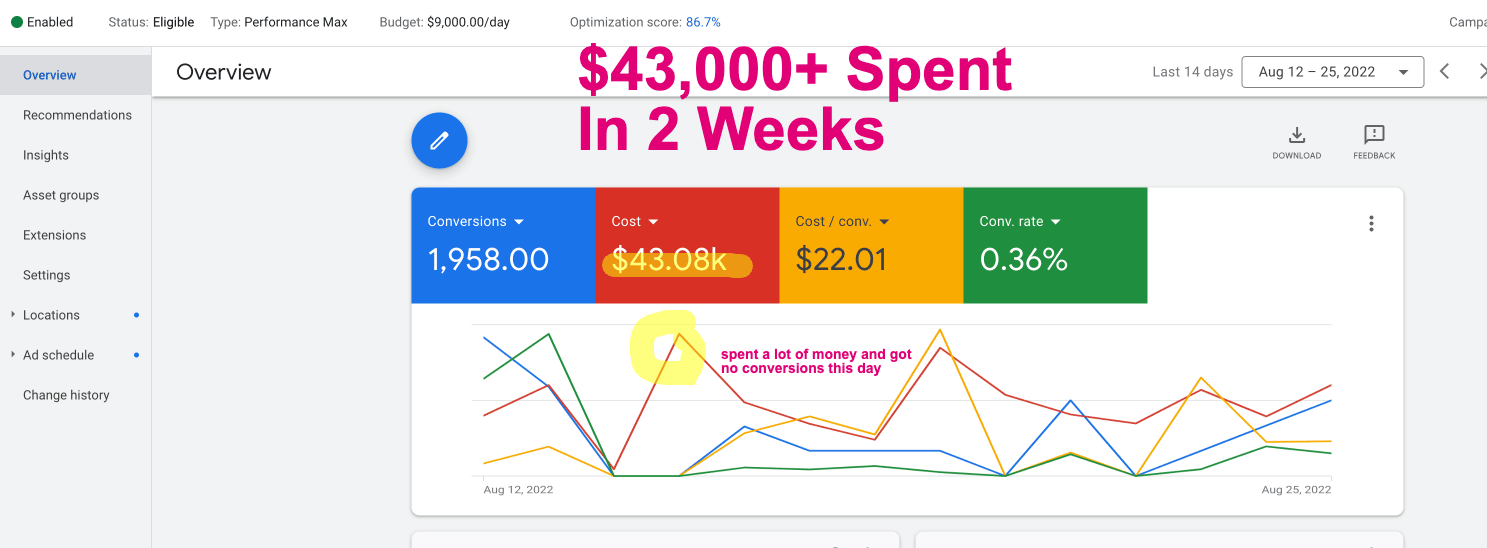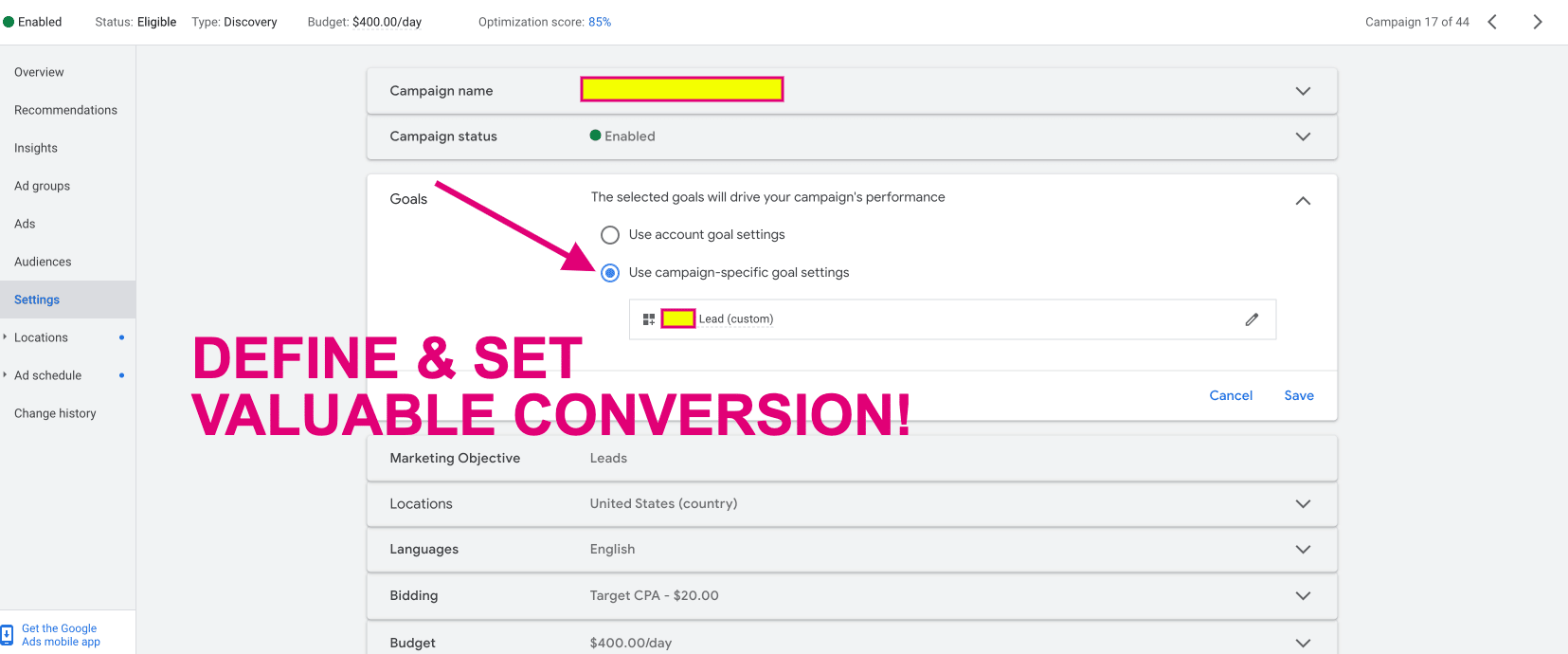In the past year Google Ads rolled out their new performance max campaign type to advertiser accounts.
As a big user and spender on Google ads for lead generation I decided to dip my toes into, and over the last 14 days I spent over $43,000 with the new campaign type.

There’s the proof! This campaign was running for about 10 days before this screenshot, at which point I applied a target CPA.
Read on and I’ll share my best practices from experience.
Here’s a quick plug, if you have trouble getting quality leads from Google Ads (performance max or other platform), please contact me.
Have A Defined Valuable Conversion
Google Performance Max Campaigns give you the advertiser, very little control over who you advertise to. Instead they basically say, “tell us what conversions you want, and we’ll figure out where to get them”.
This has many advertisers that are used to ‘controlling’ every element of their ads, concerned that unqualified leads or traffic will come through. That’s a fair concern. Unqualified traffic completing your lead forms or conversion event is a waste of money.
For e-commerce businesses, this isn’t much of a problem as the user has to make a purchase (something with direct value) by entering payment details, but for lead generation this is
That’s why it is important to make sure that the conversion event is directly tied an internal value or disqualifies out unqualified traffic. One advanced way of doing this is with a conditional conversion event that only triggers a conversion if the user answer a question (or series of) correctly. If you’re interested in having this setup, please contact me as conversion event value optimization is one of my specialties. I do have advanced methods of optimizing conversion events for problems with low quality leads, that I do not share publicly.
Make Sure Your Conversion Event Is Properly Set
This one has gotten even the most skilled Google Advertisers once or twice.
In the Campaign settings you have the option to toggle and select the conversion event. By default Google may use ‘all account conversions’ which may include random conversion events Google has set up, that likely have absolutely ZERO value.

I’ve seen Google create conversion events for things such as, loading the contact page of the website, or click on the address in Google Maps. These things have no value and are easy actions for Google to get users to take, so if left as a potential optimization event for the campaign, the campaign will report tons of conversions, spend all your budget, and all you will get is the credit card charges.
Use Video Assets
Google Performance Max campaigns can serve video ads. And the video can do very well.
Yet many marketers stay away from video because it is difficult and expensive to create. It’s time to get over that hurdle!
Yes video takes work and sometimes expensive trial and error to get working correctly, but when executed, it works extremely well and performance campaigns will get it in front of the right users.
Use A Long Form Landing Page
One thing that I do not like about performance max is that you can only set one landing page URL. This creates a conundrum with my experience in direct response marketing. From my experience, I typically create a landing page specific to the channel.
For example Google display ads which has minimal context ads paired witha low intent audience, I have found to work best with a long form landing page which includes many elements and a good bit of copy. On the other hand, with video ads I can provide all the ‘elements’ in the video so I find a short form landing page with little else beyond what is absolutely necessary for the user to take the next step works between.
In performance max campaigns, your ads will run on multiple channels. For this scenario, I have found my long form landing pages, stuffed with as many elements and details to perform best!
Do Not Use URL Expansion
In the campaign settings, buried in the additional settings is the options for ‘Final URL expansion’. By default this option is toggled on.
I turn it OFF.

When you leave this option on, Google will use ALL the URLs on your website to try and figure out what pages will drive conversions.
Here’s why I don’t like that:
- Google already will have a multitude of asset and audience options across their different platforms to test out. Now when you use all pages on your website, Google has all those options times the number of pages on your site to test out. Simply put that will create too many combinations to ‘test’ that you will have to pay for.
- Your website probably contains many pages you don’t want people to see. CMS systems often generate all kinds of unnecessary, ill-viewing pages.
- Some basic landing page intuition and best practices will convert at a better rate. If you’re trying to sell a specific product, your best page will be a page that hits the users emotions, builds trust, and directs them to buy.
There may be some exceptions to this but for 99.9999% of advertisers, sending all traffic to a specific landing page is the best practice. My philosophy is to keep it direct and simple, with one audience, one offer, one landing page. When you nail that, then you can start throwing things into the equation, but most of the time, you’ll find that simple wins.
Start With A Relatively Narrow Audience Signal
Like with the URL Expansion, the more audience signals you provide, the more testing Google will need to do with your budget. And even with relatively narrow audience signal your audience will probably be in the millions.
Let’s give this some context. Let’s say you sell a sleep mask that helps people sleep better. I might start with people that search for ‘sleep masks’. They are going to be in-market. After you’ve gotten a few hundred conversions, then I might expand to or ‘how to sleep better’ searchers, or people that are in-market for a new mattress.
Bottomline, always start narrow to direct Google to the most likely to convert.
Start Your Budget Small But Increase
Any smart bidding strategy needs to spend money to get a sample. Performance Max and it’s seemingly infinite combinations of assets, audience signals, and placements, will need more.
But still start small!
The performance Max adspend (and actual performance) behaves erratically in my opinion. One day early on in test the budget was $500/day and it spent nearly $1,500.
Then there is the problem of clickfraud, which is rampant on the performance max platform. The problems really occur when these clicks trigger conversion events. As mentioned before, this isn’t a problem for e-commerce conversions, but it is a huge problem for lead generators, in which the user doesn’t actually need to trigger a conversion. When these spam click farm leads trigger conversions they can burn through your ad spend and leave you with nothing.
So start small to make sure everything is working and your conversion event is indeed valuable.
Kill The Campaign and Shift Gears If You Spend 50x Your Target Conversion For 0 Conversions
This is rule of thumb that I apply across all advertising sources. If my ultimate goal is $20 per conversion, and I spend $1,000 without getting a conversion; it ain’t working.
I go back to the drawing board and make a MAJOR shift.
Bottomline on Performance Max Campaigns
They work incredibly well and really make things easier for advertisers that would otherwise have to set up multiple campaigns.
However they are plagued with low quality traffic and to really be successful you must have a conversion event set up and implemented properly. From there, add on these best practices, and the sky is the limit!
How are these best practices going to help you? Let me know in the comments below!
